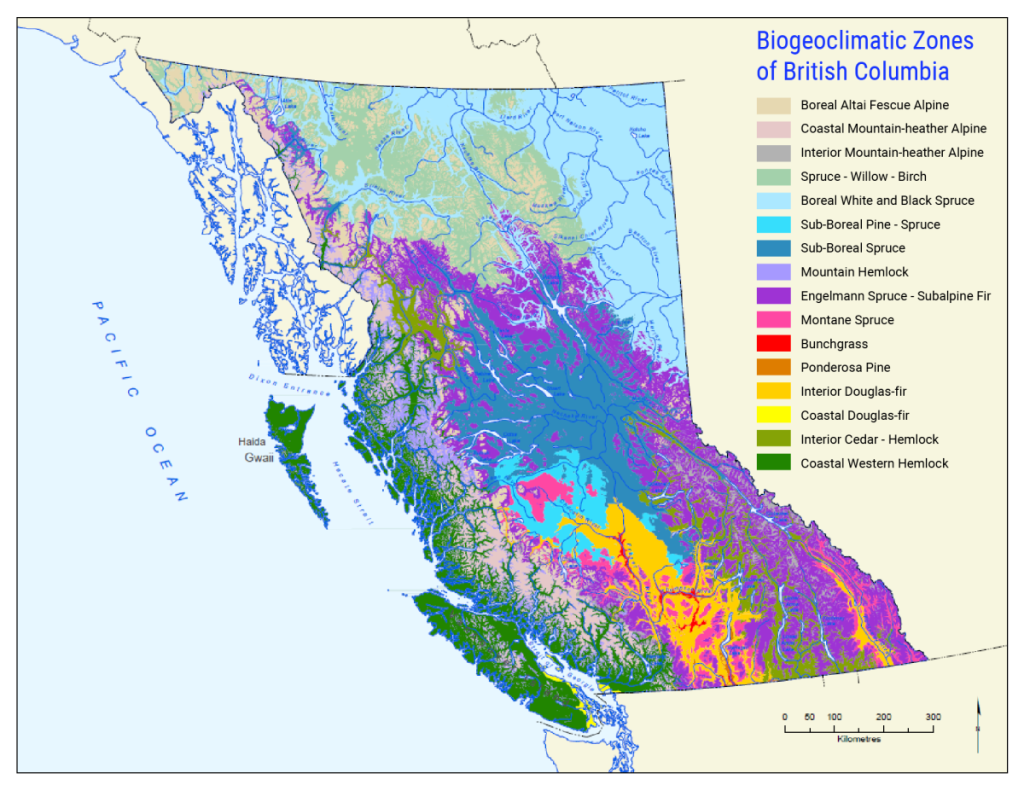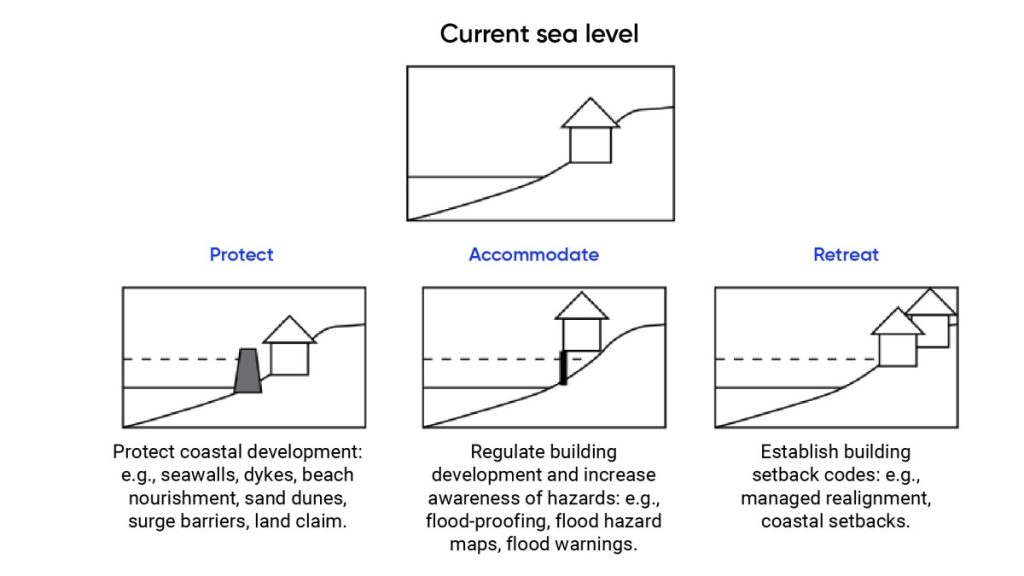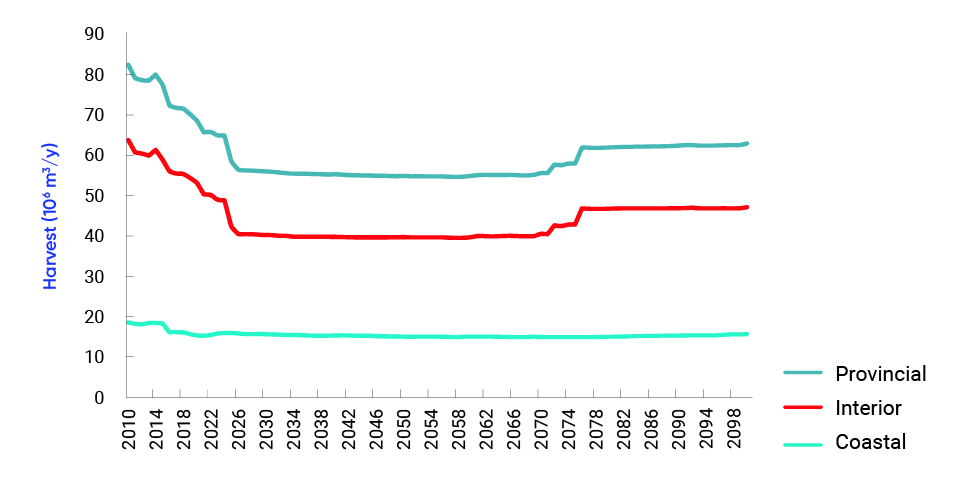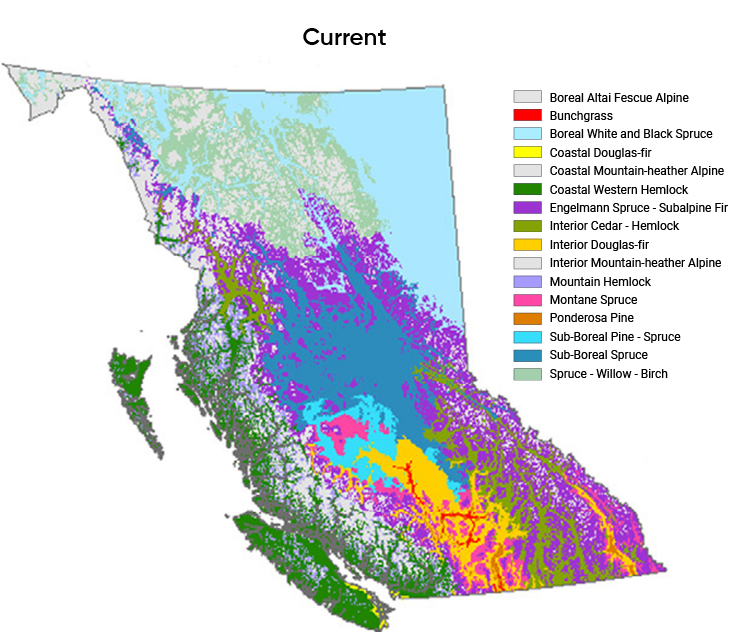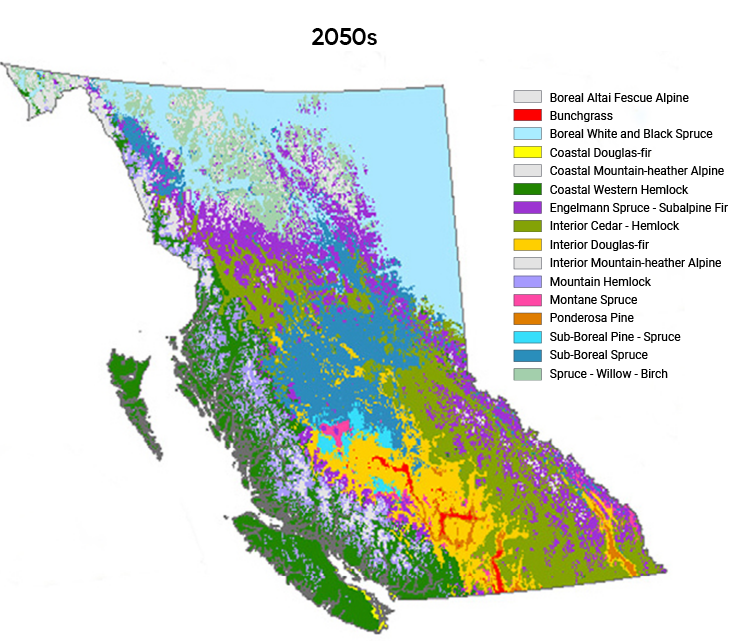B.C.’s agricultural sector employs approximately 63,000 people and produces over 200 commodities (B.C. Ministry of Agriculture, n.d.). In 2017, the sector generated approximately $14.2 billion in annual revenue (B.C. Ministry of Agriculture, 2018). This section discusses key risks for the sector, including flooding, reduced water availability, wildfire, and increases in pests, diseases and invasive species. For further discussion on agriculture and the national scale, see the Sector Impacts and Adaptation chapter.
5.5.1.1 Flooding and excess moisture
As described above, climate change is anticipated to intensify the hydrological cycle and increase precipitation variability regionally and seasonally (B.C. Ministry of Environment, 2016). Long-term projections show that these trends are expected to continue (Government of Canada, n.d.), with precipitation clustered temporally and longer drought periods, particularly for southern B.C. (Bonsal et al., 2019; Zhang et al., 2019; B.C. Ministry of Forests, Lands, and Natural Resource Operations, 2016b).
For agriculture, B.C.’s increasing seasonal precipitation presents challenges, such as contributing to spring freshet and winter runoff flooding intensification. Heavy precipitation and rapid snowmelt can cause erosion and nutrient leaching, impairing plant health and productivity (Fraser Valley Regional District, 2017). Following a severe drought or wildfire, increased precipitation may also cause erosion and site-specific flooding, resulting in crop and infrastructure losses (B.C. Ministry of Environment, 2016).
For agriculture, flood risk from winter runoff and spring thaw in the Fraser Valley is of particular concern as the area accounts for 38% of B.C.’s gross annual farm receipts (Government of B.C., 2018a). Within the Fraser Valley Regional District (FVRD), a major spring thaw flood event (1894 flood comparable) is estimated to result in $800 million in damages to producer assets and to have a $1.1 billion impact on the FVRD’s agricultural economy (Northwest Hydraulic Consultants, 2016b). Potential agricultural costs in this scenario include damage to agricultural buildings and equipment, livestock mortalities and crop losses (Northwest Hydraulic Consultants, 2016b).
Flooding is also a significant agricultural production risk elsewhere in British Columbia. (B.C. Agriculture and Food Climate Action Initiative, 2019, 2016, 2014). Floods range from larger regional occurrences—e.g., the 2018 flooding of the Kettle and Granby Rivers (Yumagulova, 2019)—to small site-specific instances. Agricultural adaptation strategies range from regional-level action, such as enhancing dyking and natural infrastructure (e.g., forests, riparian areas, floodplains and wetlands), to farm-level action, such as planting riparian buffers, improving drainage systems and adopting flood-tolerant cropping or production systems. The extent to which these measures have been explored or adopted and the degree to which agriculture is represented in risk mitigation efforts vary regionally.
Sea-level rise and storm surges also pose flooding threats to coastal agriculture, through the risk of dyke breaches, soil salinization and farmland inundation (B.C. Agriculture and Food Climate Action Initiative, 2013). For example, in B.C.’s Delta region, most agricultural land is two metres or less above sea level, and existing protection mechanisms—dykes, seawalls and pumping stations—require costly upgrades for sea-level rise protection (Delcan Corporation, 2012). For dykes alone in the wider Metro Vancouver region, the estimated cost is approximately $9.47 billion (Delcan Corporation, 2012) and the lost agricultural land from expanded or enhanced dyke systems is of concern.
Infrastructure and farming system upgrading and adaptation represent only one part of flood adaptation. Emergency response measures—including the Provincial Emergency Program (Government of B.C., 2016)—and recovery measures that emphasize rebuilding infrastructure to be more climate-resilient are important for reducing agricultural vulnerability.
5.5.1.2 Reduced water availability
The shifting seasonal distribution and intensity of precipitation pose additional challenges for B.C. agriculture. The frequency and intensity of extreme precipitation events will likely increase in southern B.C., and will be accompanied by rising summer temperatures and declining precipitation (B.C. Ministry of Environment, 2016). Less seasonal snow accumulation, hot and dry summer conditions, and reduced summer rainfall will influence the duration and frequency of seasonal drought (B.C. Ministry of Forests, Lands and Natural Resource Operations, 2016b). Consequently, agricultural drought—when soil water deficiency causes plant water stress to negatively affect crop yield and productivity—is more likely (Government of B.C., 2018a). This type of drought occurred in southern B.C., with record breaking dryness, particularly in the South Thompson, Nicola, Similkameen and Kettle basins from late August through mid-October of 2017 (Government of B.C., 2018a). Recorded agricultural impacts of this drought include heat stress, accelerated crop maturation, reduced livestock feed, limited irrigation water supply, and reduced crop quality and quantity (Agriculture and Agri-Food Canada, 2017). These conditions also contributed to the severity of the 2017 wildfire season, which caused additional negative agricultural impacts, including losses to livestock, rangeland, forage, fencing and livestock infrastructure (Agriculture and Agri-Food Canada, 2017).
With drought conditions becoming more common across B.C., longer-term water shortages are likely (B.C. Ministry of Environment and Climate Change Strategy, 2019). With increasing shortages, there will be additional demand on relief and business risk management programming (e.g., the AgriStability Program, the AgriRecovery Framework, the Production Insurance Program, the Livestock Tax Deferral Program and the Western Livestock Price Insurance Program; Government of B.C. (2018a)). Governments and industry associations are also promoting preemptive measures to help farmers prepare for drought (e.g., through enhanced on-farm water storage and drought-tolerant cropping) and reduce water demand (e.g., through precision irrigation and regional crop water demand modelling).
5.5.1.3 Wildfire
Extreme warm and dry weather conditions enhanced the severity of B.C.’s recent wildfire seasons (Kirchmeier-Young, et al., 2019). In 2017, 1.22 million hectares burned, causing a $35 to $70 million agriculture capital and revenue loss (B.C. Ministry of Forests, Lands, Natural Resource Operations and Rural Development, 2018b). Then, in 2018, 1.35 million hectares burned in B.C.’s largest wildfire season on record (B.C. Wildfire Service, 2019). Ranching operations in particular were impacted by these two wildfire seasons, with record wildfire damage and loss of animals, farm buildings, fencing, forage crops and rangeland. Additional impacts associated with wildfire include:
- the need to manage the logistics of relocating livestock and finding feed resources as the result of evacuation alerts and orders (B.A. Blackwell and Associates Ltd, 2018);
- decreased livestock health and productivity from smoke and evacuation transport (B.C. Agriculture and Food Climate Action Initiative, 2014);
- diminished crop production due to a lack of irrigation over multiple weeks for farm properties under evacuation orders;
- reduction of usable forage and pasture because of fire retardant contamination (B.C. Ministry of Agriculture, 2017);
- agri-tourism decline, particularly for Okanagan region vineyards (Abbott and Chapman, 2018; Government of B.C., 2018b);
- possible smoke taint in wine grapes, making them unfavourable for wine production (Noestheden, et al., 2018); and
- multi-year recovery challenges, such as rapid runoff from the loss of vegetation (Shakesby and Doerr, 2006) and changed soil structure, which can decrease soil productivity (DeBano, 1990) and increase erosion risks (Certini, 2005).
The B.C. wildfire seasons of 2017 and 2018 led to increased interest in reducing wildfire operational risks for agriculture. For example, the BC Cattlemen’s Association, along with the Province, is piloting the use of grazing to reduce fine fuels—such as grass, pine needles and tree moss— with the aim of reducing wildfire risk near communities, and to allow ranchers to access new forage (B.C. Ministry of Forests, Lands, Natural Resource Operations and Rural Development, 2019b). Nevertheless, as hotter and drier summers occur, and as forest susceptibility to climate impacts increases (e.g., due to increasing pest populations), wildfire risk will continue to become more severe, with predictions of up to a 4% increase in annual area burned by 2050 (B.C. Ministry of Environment and Climate Change Strategy, 2019).
5.5.1.4 Pests, disease and invasive species
Climate change is shifting the latitude and altitude range, pervasiveness and frequency of insect pests, diseases and invasive species populations (Scholefield et al., 2017a). The distribution and lifecycles of pests, diseases and invasive species are being influenced by increases in annual temperatures, growing-degree days (GDDs), growing season length, winter/spring precipitation and extreme rain events, as well as drier summer conditions and warmer winters. The introduction of new pests, diseases and invasive species, the changes in number of generations possible in a single season, and the potential for reduced efficacy of management control measures have the potential to affect both crop and livestock producers (Beddington et al., 2012).
An example of a destructive pest identified in B.C.’s Fraser Valley in 2009 is the Spotted Wing Drosophila Fruit Fly (D. suzukii) (B.C. Ministry of Agriculture, 2014). This soft-skinned fruit pest lays eggs in ripe fruit (e.g., berries); consequently, high canopy humidity and ripe and over-ripe fruit create infestation risks. While the presence of this pest is not climate change-induced, milder winters and warmer summer conditions likely increase the abundance and range of this pest, placing an elevated risk on small fruit and tree fruit crops in northern latitude regions (Langille et al., 2017). Studies undertaken in the Cariboo Region (i.e., Powell, 2018) and the Fraser Valley region (i.e., Scholefield et al. 2017a) have identified additional pests of concern that may shift in abundance and range as climate conditions change. Responses to these pests to date have been limited as there is opposition to long-term and landscape-level efforts in some jurisdictions (Scholefield et al., 2017a). Monitoring efforts in B.C. have tended to be relatively short-term and location-specific, focusing on select crops, pests, diseases or invasive species (B.C. Agriculture and Food Climate Action Initiative, 2015).
